
Out of Place, Out of Bounds
Juried by Tom Lundberg and Steven Frost

Tom Lundberg
Tom Lundberg is a visual artist who lives in Fort Collins, Colorado. He is professor emeritus in the Department of Art & Art History at Colorado State University, where he coordinated the program in fibers. Lundberg has lectured and led workshops in the United States, England, Ireland, Italy, New Zealand, and South Korea. Lundberg began university studies at Iowa State University, apprenticed with potter Clary Illian, and completed his BFA in painting at the University of Iowa. Lundberg received his MFA in textiles from Indiana University. His embroideries are exhibited internationally and are in collections of New York’s Museum of Art and Design; Renwick Gallery, Smithsonian American Art Museum; Arkansas Arts Center; Indianapolis Museum of Art; State of New Mexico Art in Public Places; Chase Manhattan Bank, New York; Racine Art Museum; Museum of Fine Arts, Boston; University of Louisville; and Kaiser Foundation Health Plan, Denver. His work was showcased in a feature exhibition at the 2019 International Fiber Art Fair, Seoul Arts Center, South Korea.

Steven Frost
Steven Frost (they/them) is an instructor in the Department of Media Studies, an interdisciplinary fiber artist, and the Faculty Director of the B2 Center for Media, Arts, and Performance at the University of Colorado, Boulder. Their research focuses on textiles, memes, queer history, pop culture, and community development in DIY spaces and libraries. In their studio practice, they often combine traditional materials like wool and cotton with non-traditional materials from a range of sources, exploring the ways history and time are embedded in materials. Their artworks evoke specific narratives and stories, referencing aspects of their personal and family history, and the history of the LGBTQIA+ people, among other topics. In workshops and interactive performance events, they work to amplify marginalized voices and foster communities to produce their own forms of representation.
Frost has been featured in solo and two-person exhibitions at the Boulder Museum of Contemporary Art (Boulder, CO), Basement Projects (Santa Ana, CA), CU Boulder Art Museum (Boulder, CO), 350 E 3rd/ ArtX (Long Beach, CA), Robert Bills Contemporary (Chicago, IL), Coop Gallery (Nashville, TN), and Pleasant Plains Workshop (Washington, DC) and in group exhibitions at Union Hall Gallery (Denver, CO), the Center for Visual Arts (Denver, CO), Alto Gallery (Denver, CO), Arlington Arts Center (Arlington, VA), Wignall Museum of Contemporary Art (Rancho Cucamonga, CA), Imersten (Vienna, Austria), ACRE Gallery (Chicago, IL), Chicago Cultural Center (Chicago, IL), and the AU Museum at the Katzen (Washington, DC) among other venues. They’ve recently taught workshops at the Art Student’s League (Denver, CO), Redline Contemporary Art Center (Denver, CO), School of the Art Institute of Chicago (Chicago, IL), and the Haystack School of Crafts (Deer Isle, ME). Frost is the founder of the Colorado Sewing Rebellion, an offshoot of the original Sewing Rebellion founded by Frau Fiber (Carole Francis Lung). They are a co-founder of the Experimental Weaving Residency (with Dr. Laura Devendorf). Frost is also is a recipient of several other honors including the Lenore G. Tawney Fellowship and the Luminarts Cultural Foundation Fellowship. They hold an MFA in Fiber and Material Studies from the School of the Art Institute of Chicago and a BFA from the New York State College of Ceramics & Design at Alfred University.

Arda Asena | Let Me Go | Mohair, wool, viscose, cotton, alpaca wool | I Wanted to Relocate Him | Viscose, wool, paper, mohair, silk, polyester, alpaca wool, cotton | I am interested in investigating the ways queer existence has been abstracted in attempts to represent queerness as a threat to Islamic landscape. I depict imaginary landscapes that attends to notions of secretive eroticism, often employed as a mode of survival by queer people in the face of social and cultural violence. I recognize queerness as limitless formations where I’m able to create and claim space for it in the imaginary landscapes that I weave.

Arda Asena | I Wanted to Relocate Him | Viscose, wool, paper, mohair, silk, polyester, alpaca wool, cotton | I am interested in investigating the ways queer existence has been abstracted in attempts to represent queerness as a threat to Islamic landscape. I depict imaginary landscapes that attends to notions of secretive eroticism, often employed as a mode of survival by queer people in the face of social and cultural violence. I recognize queerness as limitless formations where I’m able to create and claim space for it in the imaginary landscapes that I weave.

Driving Down the Wind River Canyon 1-4 | Embroidery and ink on linen | Meditation on driving, motion, space, and time.

Driving Down the Wind River Canyon 1-4 | Embroidery and ink on linen | Meditation on driving, motion, space, and time.

Driving Down the Wind River Canyon 1-4 | Embroidery and ink on linen | Meditation on driving, motion, space, and time.

Driving Down the Wind River Canyon 1-4 | Embroidery and ink on linen | Meditation on driving, motion, space, and time.

Christy Nelson | Exposed | Salvaged zipper and inherited lace in encaustic | I find used objects and using art agents like encaustic and thread, I stitch them together into new things. The process of altering salvaged fabrics and representing them in a moment of restoration is empowering. In this particular body of work the materials are all from my grandparents' estate. In their home these objects provided comfort and utility. Their relocation to my studio brought a palpable safety that fostered my vulnerability. Their tattered edges and stains resonate with a usage that is familiar to me, while the soft color palettes whisper of prior experiences. As the artworks exist in their re-formed state, leaving my studio and entering the gallery, they push into a shared space with the viewer—bringing a confrontational history of damage and offering a fragile, yet tangible, hope of renewal
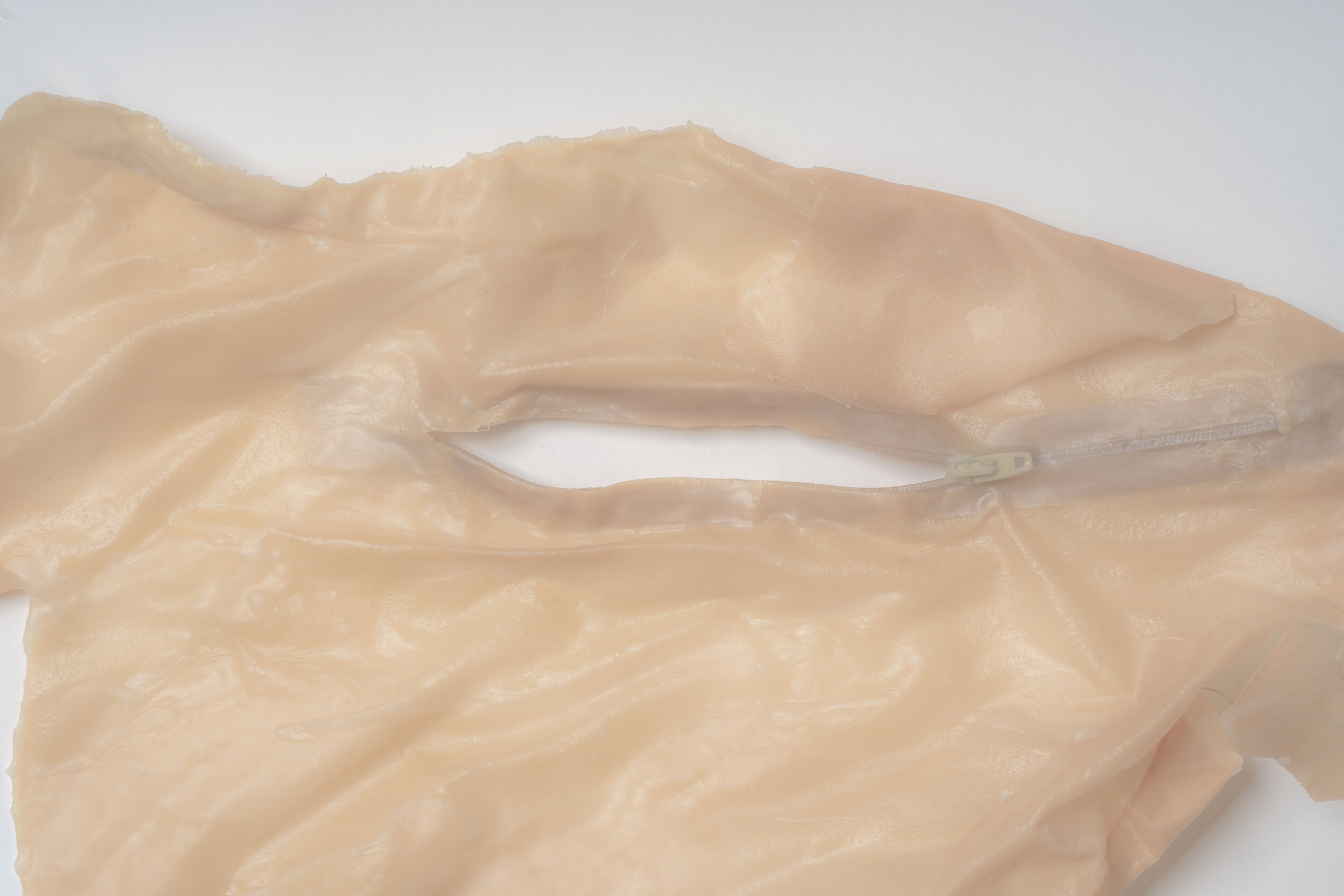
Christy Nelson | Strip | Fabric and zipper in encaustic | I find used objects and using art agents like encaustic and thread, I stitch them together into new things. The process of altering salvaged fabrics and representing them in a moment of restoration is empowering. In this particular body of work the materials are all from my grandparents' estate. In their home these objects provided comfort and utility. Their relocation to my studio brought a palpable safety that fostered my vulnerability. Their tattered edges and stains resonate with a usage that is familiar to me, while the soft color palettes whisper of prior experiences. As the artworks exist in their re-formed state, leaving my studio and entering the gallery, they push into a shared space with the viewer—bringing a confrontational history of damage and offering a fragile, yet tangible, hope of renewal

Christy Nelson | Strip | Fabric and zipper in encaustic | I find used objects and using art agents like encaustic and thread, I stitch them together into new things. The process of altering salvaged fabrics and representing them in a moment of restoration is empowering. In this particular body of work the materials are all from my grandparents' estate. In their home these objects provided comfort and utility. Their relocation to my studio brought a palpable safety that fostered my vulnerability. Their tattered edges and stains resonate with a usage that is familiar to me, while the soft color palettes whisper of prior experiences. As the artworks exist in their re-formed state, leaving my studio and entering the gallery, they push into a shared space with the viewer—bringing a confrontational history of damage and offering a fragile, yet tangible, hope of renewal

Eleanor Anderson | Intuitive Cartography #3 | Machine embroidery, hand-embroidery on hand-dyed canvas. Other materials include felt, puzzle pieces, mesh and seed beads | Through my art, I engage in world-making through the process of play and material-errantry. I use craft traditions as a flexible constraint, looking for openings in the making process where I can ply confident imperfections and deviations. My work seeks to alleviate daily doldrums and spiritless ways of living – instead, transforming spaces into paratelic experiences. I gift works to the viewer as an optimistic nudge towards joy, connection and a playful awareness of how the larger world could be.
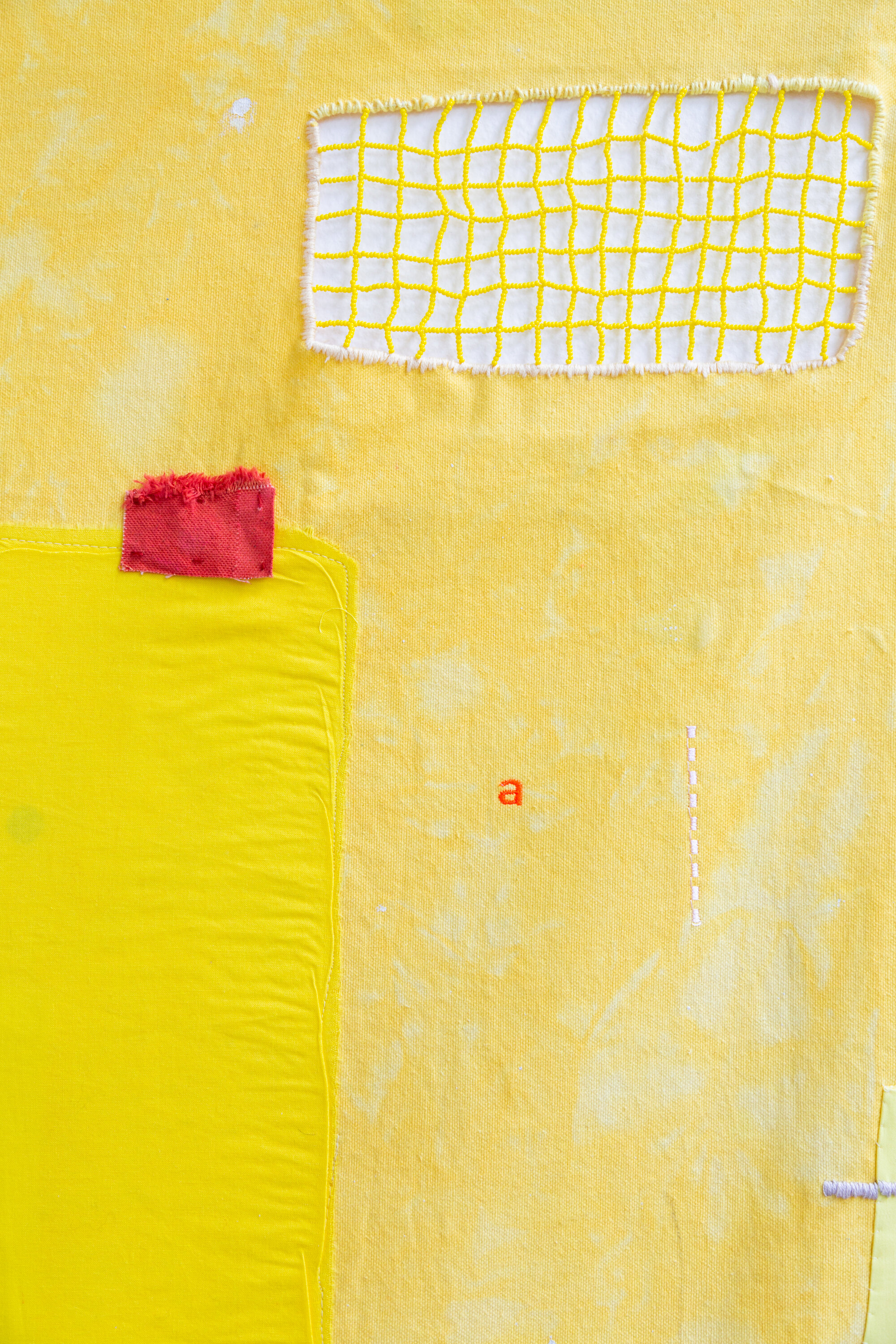
Eleanor Anderson | Intuitive Cartography #3 | Machine embroidery, hand-embroidery on hand-dyed canvas. Other materials include felt, puzzle pieces, mesh and seed beads | Through my art, I engage in world-making through the process of play and material-errantry. I use craft traditions as a flexible constraint, looking for openings in the making process where I can ply confident imperfections and deviations. My work seeks to alleviate daily doldrums and spiritless ways of living – instead, transforming spaces into paratelic experiences. I gift works to the viewer as an optimistic nudge towards joy, connection and a playful awareness of how the larger world could be.

Eleanor Anderson | Intuitive Cartography #3 | Machine embroidery, hand-embroidery on hand-dyed canvas. Other materials include felt, puzzle pieces, mesh and seed beads | Through my art, I engage in world-making through the process of play and material-errantry. I use craft traditions as a flexible constraint, looking for openings in the making process where I can ply confident imperfections and deviations. My work seeks to alleviate daily doldrums and spiritless ways of living – instead, transforming spaces into paratelic experiences. I gift works to the viewer as an optimistic nudge towards joy, connection and a playful awareness of how the larger world could be.
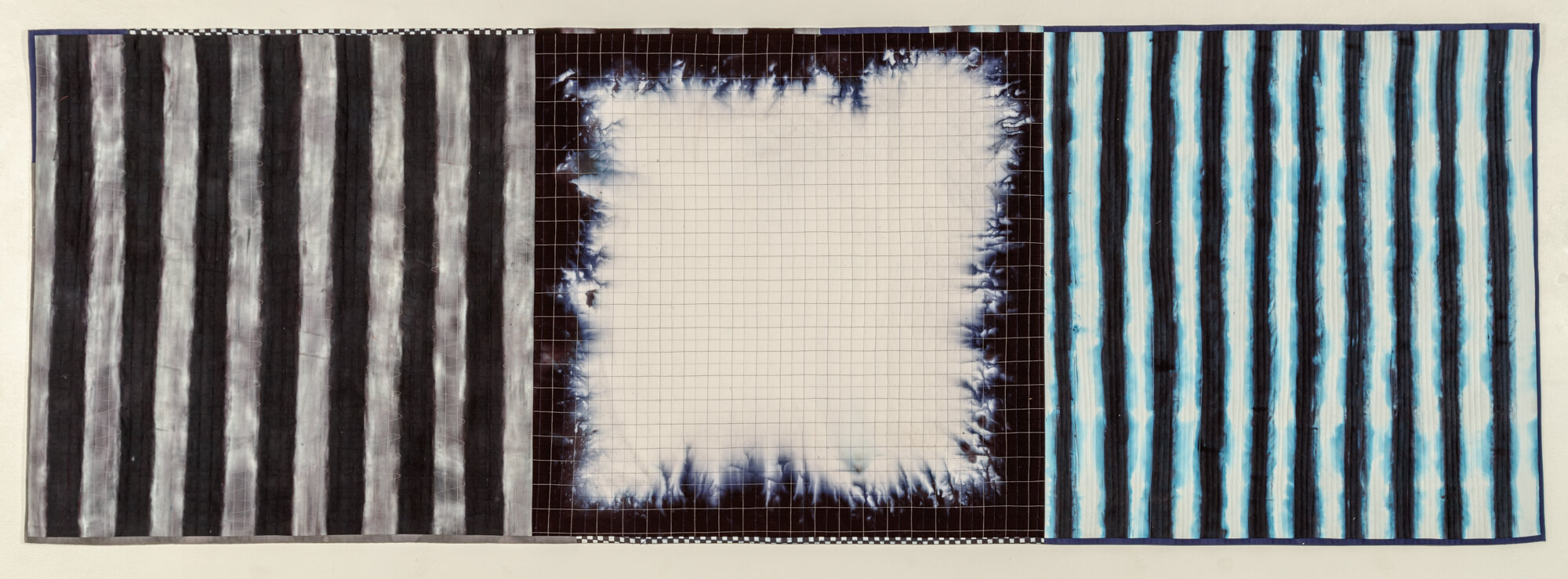
Mary Anne Jordan | Melting Block | A sign or warning signal about climate change. There is a kind of beauty in the image that portends disaster. We cannot life, rather than something to disguise.

Mary Anne Jordan | Melting Block | A sign or warning signal about climate change. There is a kind of beauty in the image that portends disaster. We cannot life, rather than something to disguise.

Mary Anne Jordan | Black Box Flag | References to flags, identity, and sense of place are used as impetus for this work. Smeared lines, running color is a mark of humanness, imperfection, a history of use, and indication of defiance or resistance to systematic order.

Mary Anne Jordan | Black Box Flag | References to flags, identity, and sense of place are used as impetus for this work. Smeared lines, running color is a mark of humanness, imperfection, a history of use, and indication of defiance or resistance to systematic order.

Rebecca Mezoff | Displaced: Refugee Blanket | wool, cotton | Steel gray blankets are handed to migrants as they stumble off boats or planes or through barbed wire fences, guards with guns nearby. This piece asks the USA to consider our role in the desperation of migrants the world over. Unseen by the viewer, paths are carved into the fiber as the textile is used for warmth and comfort and perhaps left along the side of the road somewhere.
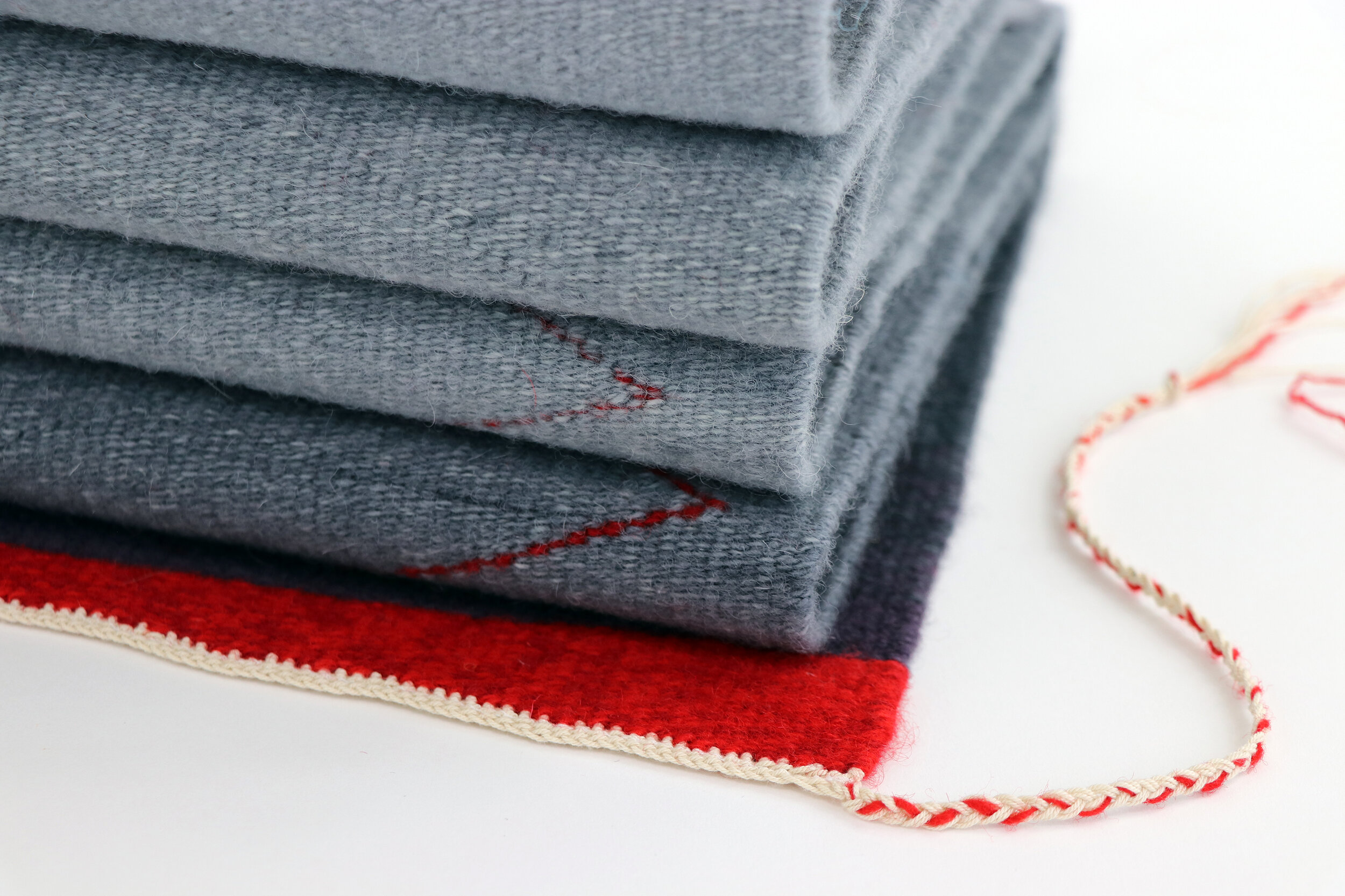
Rebecca Mezoff | Displaced: Refugee Blanket | wool, cotton | Steel gray blankets are handed to migrants as they stumble off boats or planes or through barbed wire fences, guards with guns nearby. This piece asks the USA to consider our role in the desperation of migrants the world over. Unseen by the viewer, paths are carved into the fiber as the textile is used for warmth and comfort and perhaps left along the side of the road somewhere.
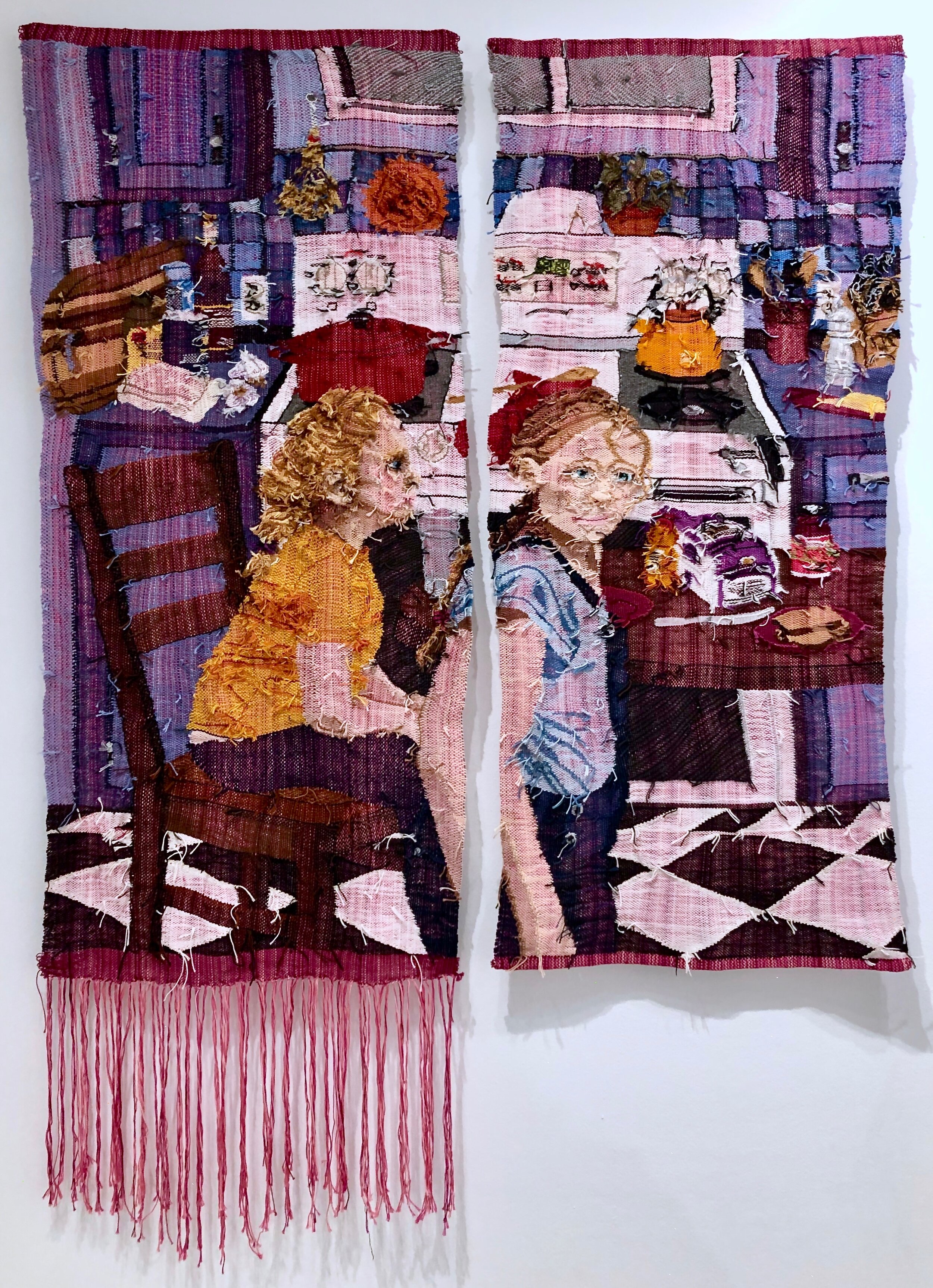
Hannah Cofer | Blue Kitchen | Cotton | Tapestry of my little sisters on a Saturday afternoon in my mother’s kitchen. Rachel (right) is nine. Emily (left) is seven.

Brooks Harris Stevens | Mending Moss | Tuffted | Mending Moss explores the interstitial spaces of our built environment to expose what needs mending. While so many facets of our lives, landscape and built environment need mending, they are so often overlooked and deemed not worthy of repair. Each tufted piece in this installation is a metaphorical mending mimicking mortar used to hold bricks together. This inclusive mending is an expression of my actions and activism, which ultimately support our fellow humankind to make positive change.

Brooks Harris Stevens | Mending Moss | Tuffted | Mending Moss explores the interstitial spaces of our built environment to expose what needs mending. While so many facets of our lives, landscape and built environment need mending, they are so often overlooked and deemed not worthy of repair. Each tufted piece in this installation is a metaphorical mending mimicking mortar used to hold bricks together. This inclusive mending is an expression of my actions and activism, which ultimately support our fellow humankind to make positive change.

Erica Greene | California King | Mattress, heavy safety blanket of knotted felt and fibers | The essence of this print is the improvised physical rhythm that it captures. The plate for this print was created quickly, without hesitation. It is a physical process, but also one that relies on the rhythms and precision. Generally, my work is spontaneous, yet deliberate. I like taking risks and accepting challenges that open up new possibilities in my work. It is this uncertainty and ambiguity that keeps me going.

Erica Greene | California King | Mattress, heavy safety blanket of knotted felt and fibers | The essence of this print is the improvised physical rhythm that it captures. The plate for this print was created quickly, without hesitation. It is a physical process, but also one that relies on the rhythms and precision. Generally, my work is spontaneous, yet deliberate. I like taking risks and accepting challenges that open up new possibilities in my work. It is this uncertainty and ambiguity that keeps me going.

Erica Greene | California King | Mattress, heavy safety blanket of knotted felt and fibers | The essence of this print is the improvised physical rhythm that it captures. The plate for this print was created quickly, without hesitation. It is a physical process, but also one that relies on the rhythms and precision. Generally, my work is spontaneous, yet deliberate. I like taking risks and accepting challenges that open up new possibilities in my work. It is this uncertainty and ambiguity that keeps me going.

Elizabeth Morisette | “A Patchwork of Data” | Quilted patchwork squares created using scrap material from 1,000 fabric masks Thread, fabric, plastic rings | This piece was created during the first months of the Covid-19 Vaccine rollout. I heard a news report saying that the rollout was a ‘patchwork’ and states were being vaccinated at vastly different rates. During the pandemic I sewed 1000 masks and sent them to people throughout the United States. I decided to take fabric scraps from these masks and create a series of quilted squares depicting each state of the union. I have taken Centers for Disease Control (CDC) Data of Vaccination rates state by state from July 1, 2021 and assembled these squares according to this data. Below are the states ranked by the percentage of their population that has been fully vaccinated against COVID-19, according to the CDC.

Heather Schulte | Permission to Enter | Wool | This piece is patterned with a visual binary code translation of part of FB/Instagram's "Terms and Conditions." Completed in March of 2020, this unintentional timing gave me pause. The threshold of public/private is negotiable space. Turning to digital apps enabled new, and needed, connections and also collapsed social boundaries. How do we navigate this liminal space predicated on opaque legal language rather than community consent? Whose space is this? Who is it for?
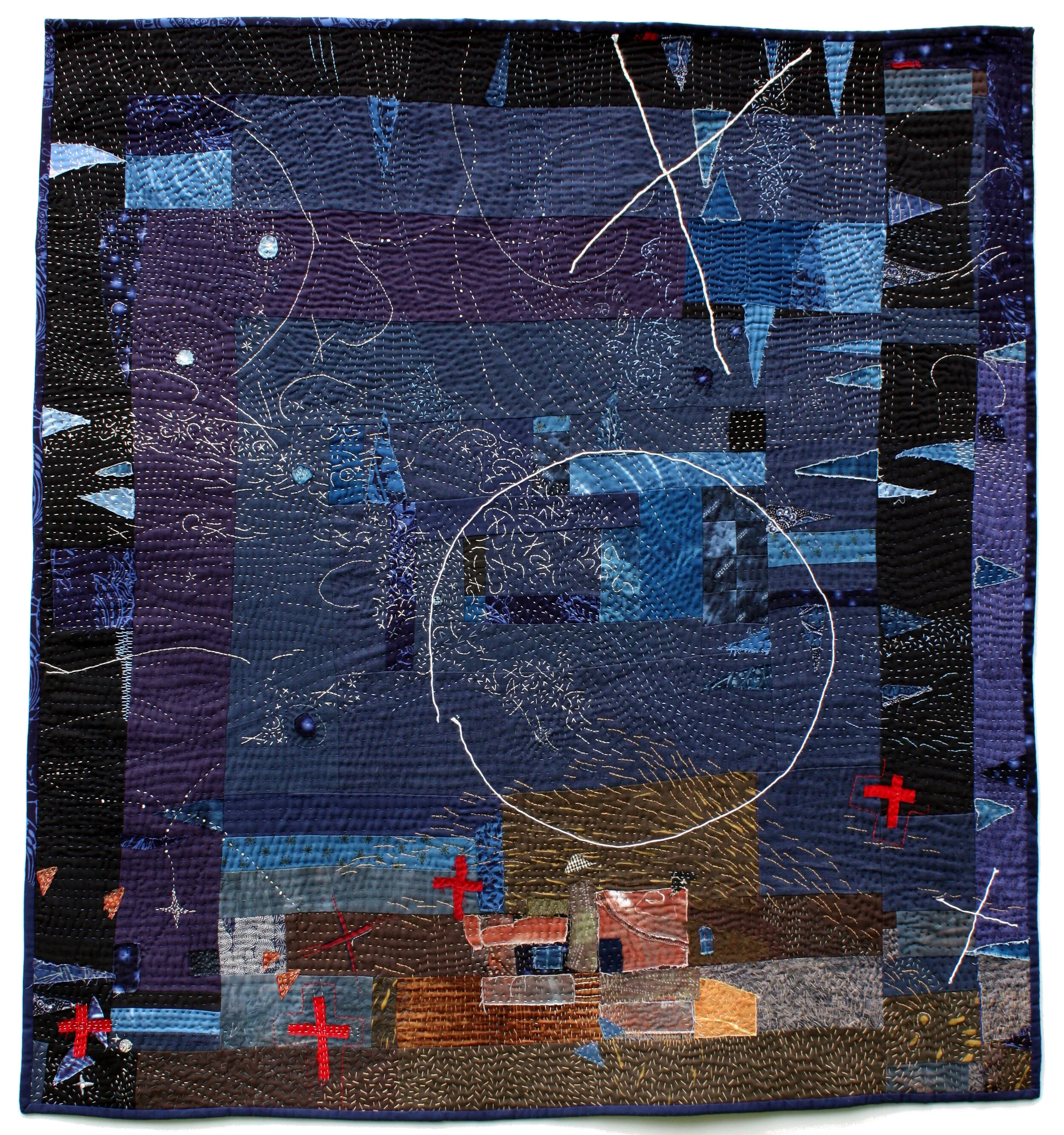
Helen Geglio | Territorial Road: Crosses and Losses | Linen, cotton, hand-embroidered and stitched | This work is inspired by a diary entry, written by Susan Brackney Clayton in 1890 from a sod house on a homestead near Elton, Nebraska. Her words tell of beauty in the expanse of land and sky, the constantly howling wind, and a deep longing for a life left behind in Indiana. Crosses and Losses refers to a patchwork pattern dating back to the time of westward expansion and speaks to the hardships and isolation of a woman uprooted.

Sui Park | Relation II 1-3 | Monofilament | Relation Series visualizes our relationships, connections, associations or relevance to another. Each piece in the Series combines two separate forms in a way that represents a particular relation. Every relation begins from somewhere, like the first weave in each piece. Some develop, accumulate and form into certain shapes, while others end early and separate. Relation Series explores some of their shapes in abstract forms, and attempt to extend and reinterpret their possibilities.

Sui Park | Relation II 1-3 | Monofilament | Relation Series visualizes our relationships, connections, associations or relevance to another. Each piece in the Series combines two separate forms in a way that represents a particular relation. Every relation begins from somewhere, like the first weave in each piece. Some develop, accumulate and form into certain shapes, while others end early and separate. Relation Series explores some of their shapes in abstract forms, and attempt to extend and reinterpret their possibilities.

Sui Park | Relation II 1-3 | Monofilament | Relation Series visualizes our relationships, connections, associations or relevance to another. Each piece in the Series combines two separate forms in a way that represents a particular relation. Every relation begins from somewhere, like the first weave in each piece. Some develop, accumulate and form into certain shapes, while others end early and separate. Relation Series explores some of their shapes in abstract forms, and attempt to extend and reinterpret their possibilities.

Melanie Walker Puppet Show: The Sleepwalker Mixed Media with toned cyanotype Puppets are figures of metamorphosis residing between the imagined and the real. Their ancient history was in the service of the people, the voice of the everyman, expression of dissent, protest and the real human concerns of everyday life. Drawing from this long history, The Sleepwalker is part of a long term allegorical project called The Househead Chronicles and represents a questioning of human motivations. Are there invisible strings that determine our actions and decisions?
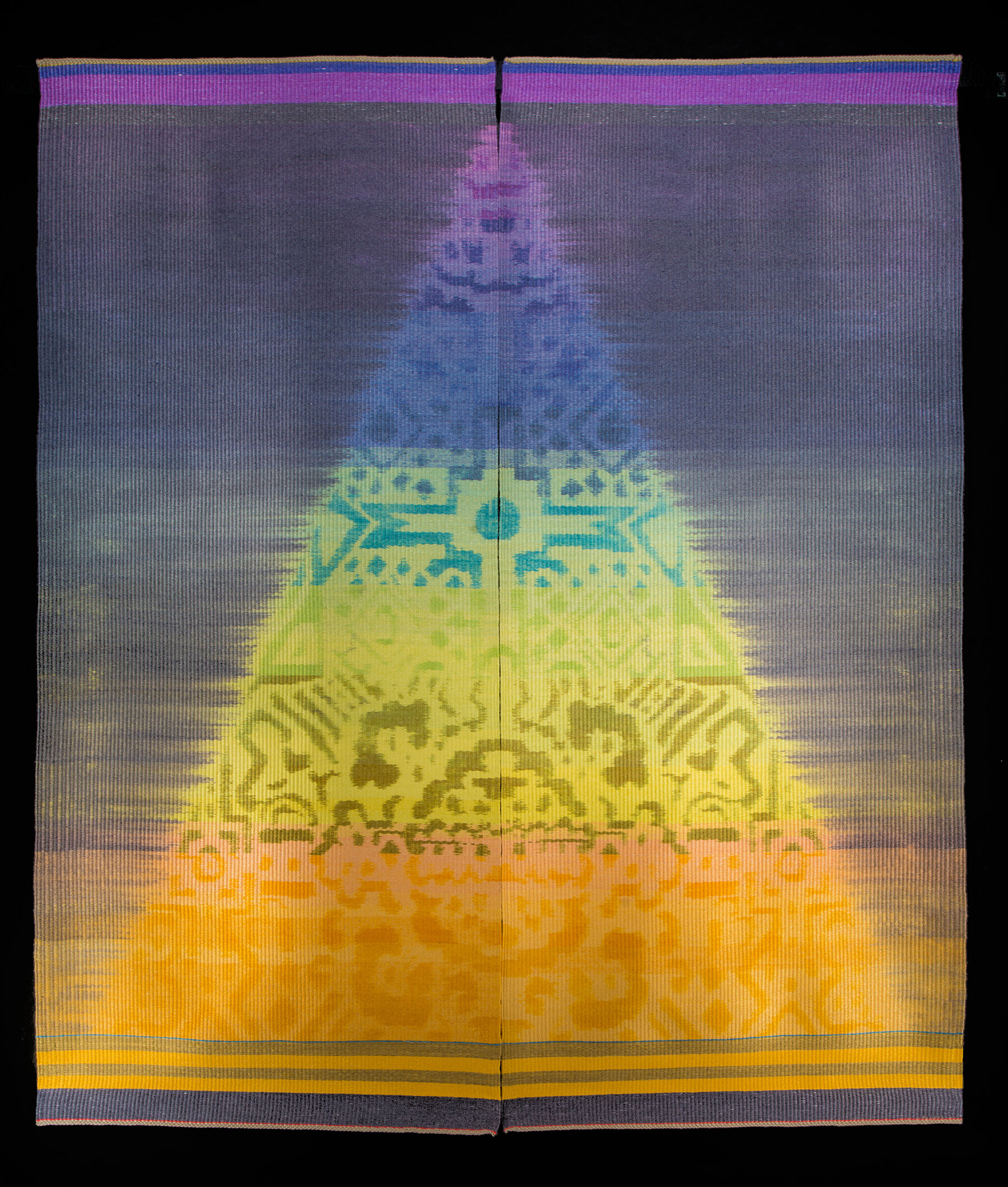
Mary Zicafoose | Mountain for the Buddha: Luma | I create woven tapestries that are as visually compelling as they are narrative. My image making incorporates text, landscape, and archetypal symbols, color saturated and technically layered using the complex resist dye process of weft ikat. My blending of the archetypal and the innovative results in textiles that span centuries of artistic tradition and situates them squarely within the contemporary visual lexicon. Raised as a midwestern Catholic, in high school, my spiritual foundation was shaken by the death of my brother. This event challenged my belief system, and I have spent a lifetime as a traveller on a spiritual journey, in pursuit of a place of metaphysical truth.

Mary Zicafoose | Mountain for the Buddha: Luma | I create woven tapestries that are as visually compelling as they are narrative. My image making incorporates text, landscape, and archetypal symbols, color saturated and technically layered using the complex resist dye process of weft ikat. My blending of the archetypal and the innovative results in textiles that span centuries of artistic tradition and situates them squarely within the contemporary visual lexicon. Raised as a midwestern Catholic, in high school, my spiritual foundation was shaken by the death of my brother. This event challenged my belief system, and I have spent a lifetime as a traveller on a spiritual journey, in pursuit of a place of metaphysical truth.
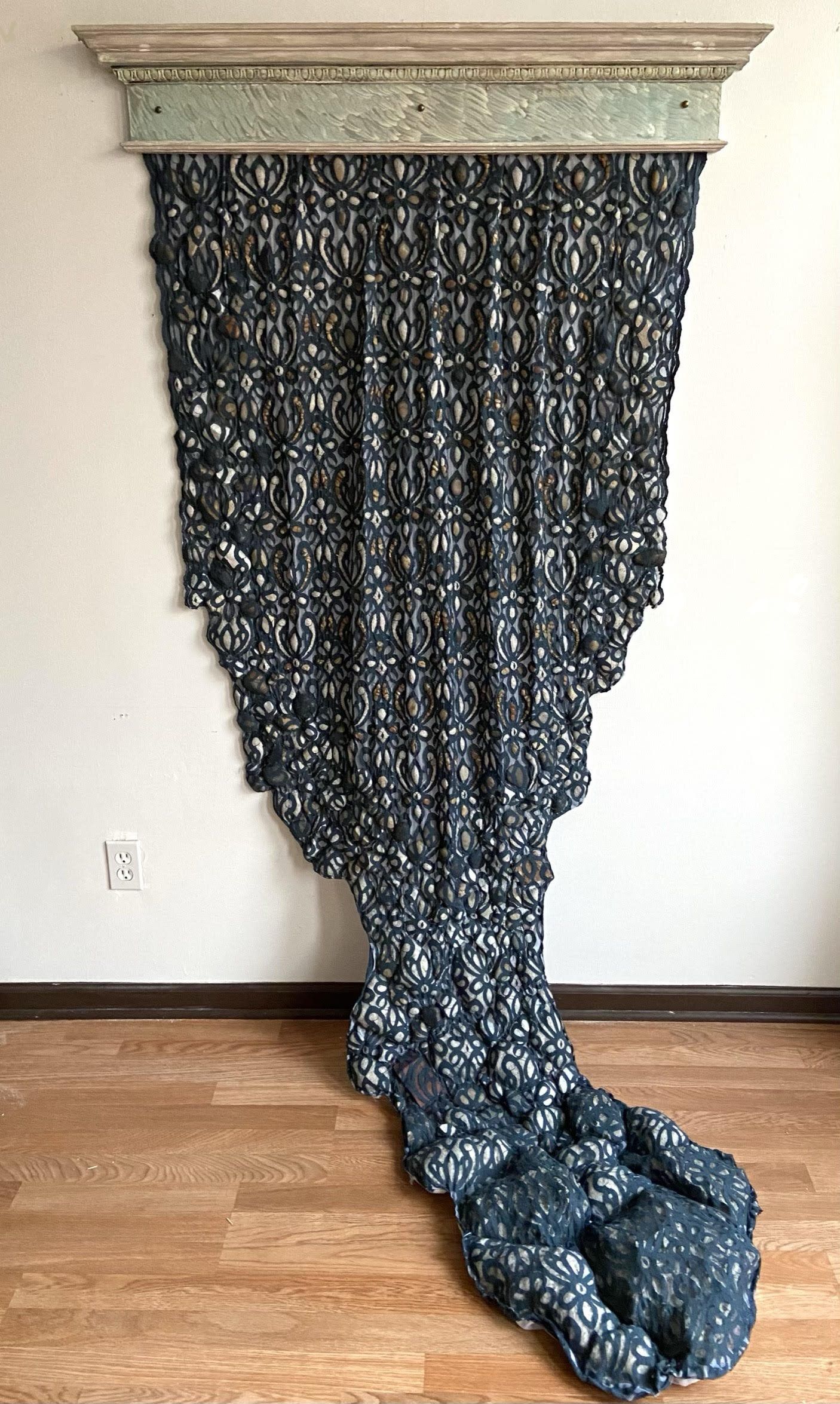
Millicent Kennedy | Inheritance | Cotton, gravel and bricks in lace, found door

Made in response to The Weaving Mill's residency working with raw cotton, this work is a meditation on the histories of materials as they relate to labor and those that benefit from them. This work takes everyday materials with troubled histories that are often forgotten, cotton, indigo, gravel and concrete, and uses them as a weight to tether down the symbols of success at others expense that we have inherited as a nation. My hope with this work was always to create an elegy, a meditate on labor, and the history we’ve inherited and a gesture to the empathy we owe our neighbors.
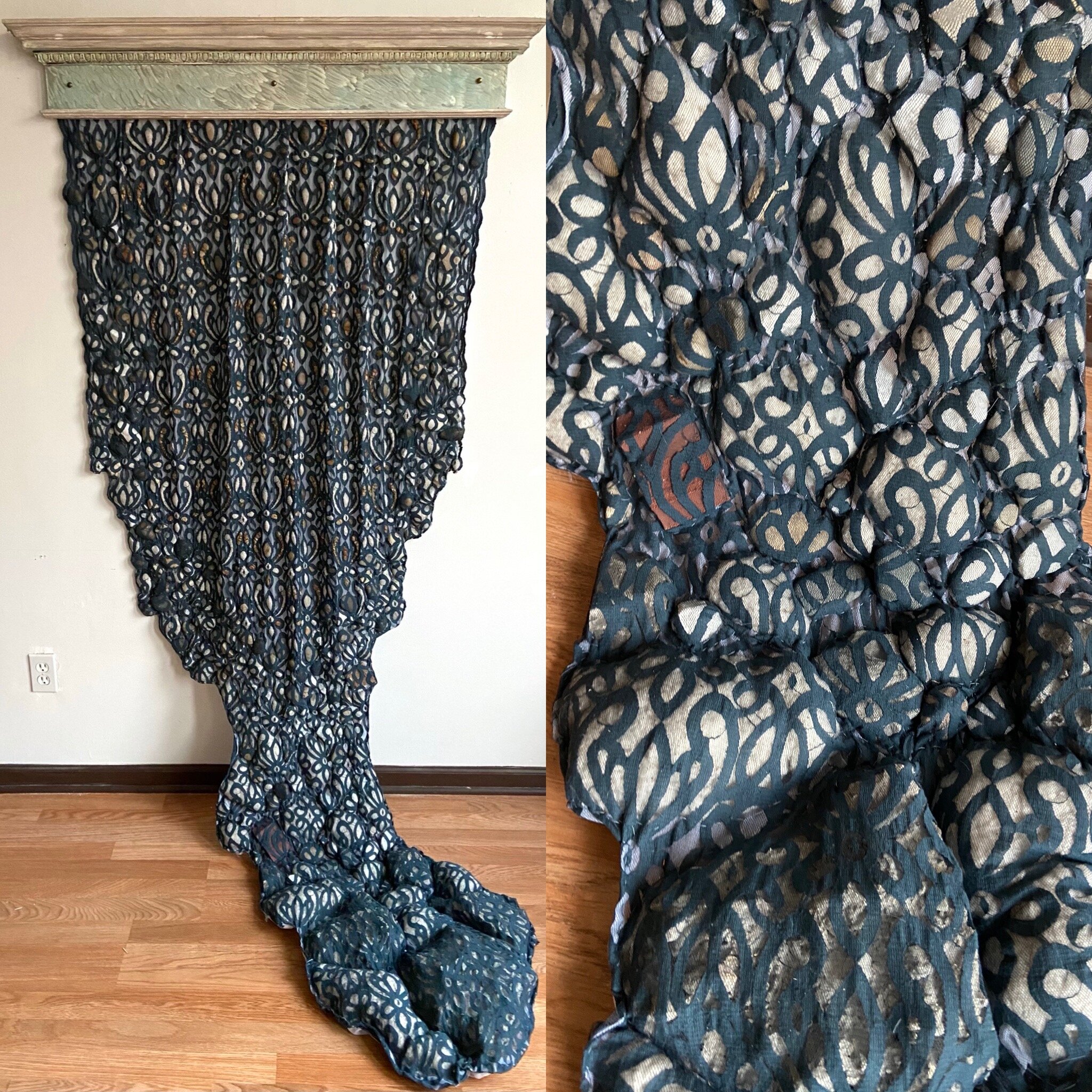
Made in response to The Weaving Mill's residency working with raw cotton, this work is a meditation on the histories of materials as they relate to labor and those that benefit from them. This work takes everyday materials with troubled histories that are often forgotten, cotton, indigo, gravel and concrete, and uses them as a weight to tether down the symbols of success at others expense that we have inherited as a nation. My hope with this work was always to create an elegy, a meditate on labor, and the history we’ve inherited and a gesture to the empathy we owe our neighbors.
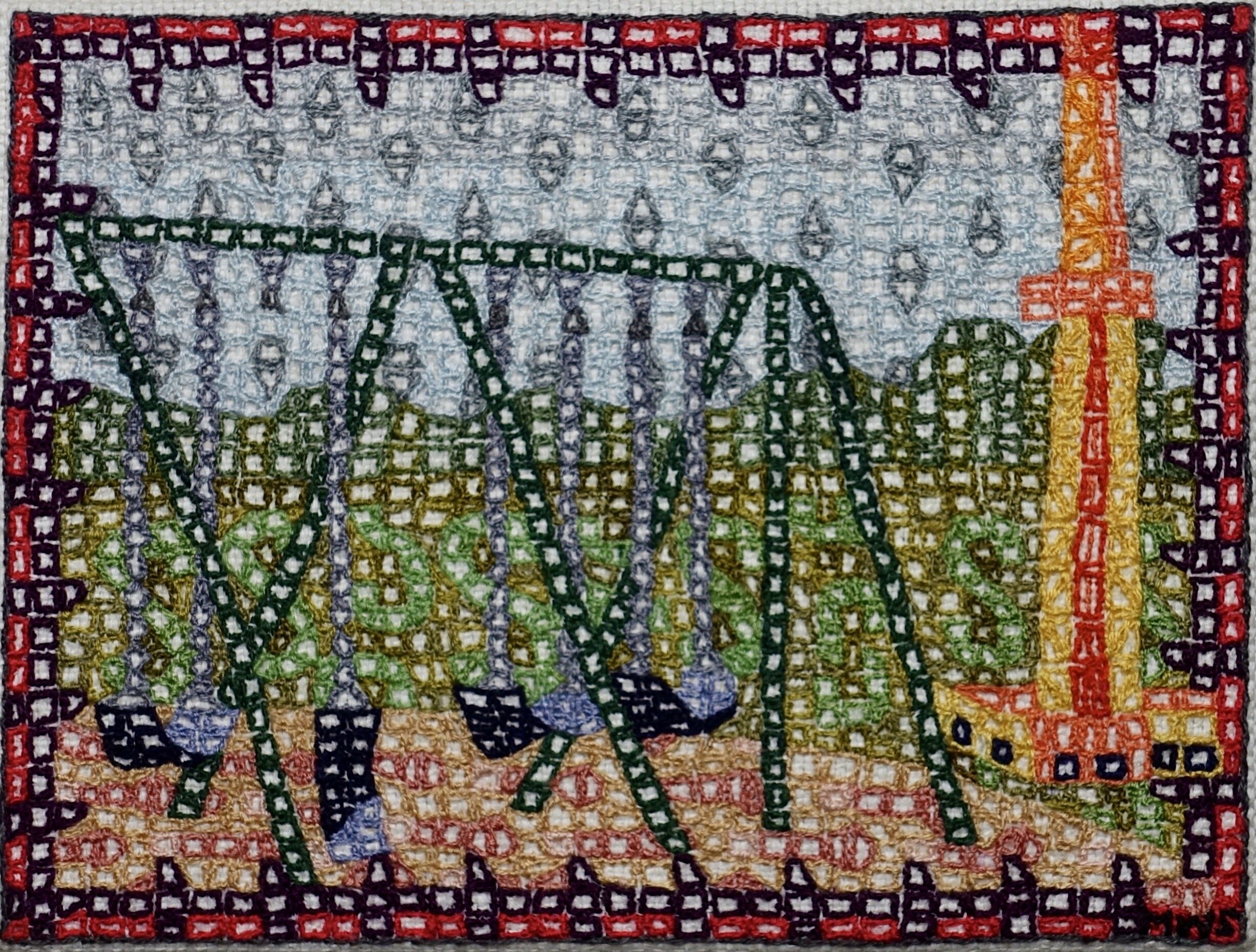
Martha Shade | Fracking Elementary School | Hand-stitched cotton thread on linen Part of my 'Fracking Weld County' series, this piece is a symbolic depiction of a playground at an Elementary School in Greeley, Co., where a fracking site was placed 1200 ft. away. Inspired by Afghan war rugs, its landscape includes air particles, dollar signs, and drill bits. Part of my 'Fracking Weld County' series, this small hand-stitched piece is a symbolic depiction of drilling paraphernalia within a neighborhood. I created it by referencing photographs of actual fracking sites in Weld County, Colorado. Inspired by woven textiles, especially Afghan war rugs.
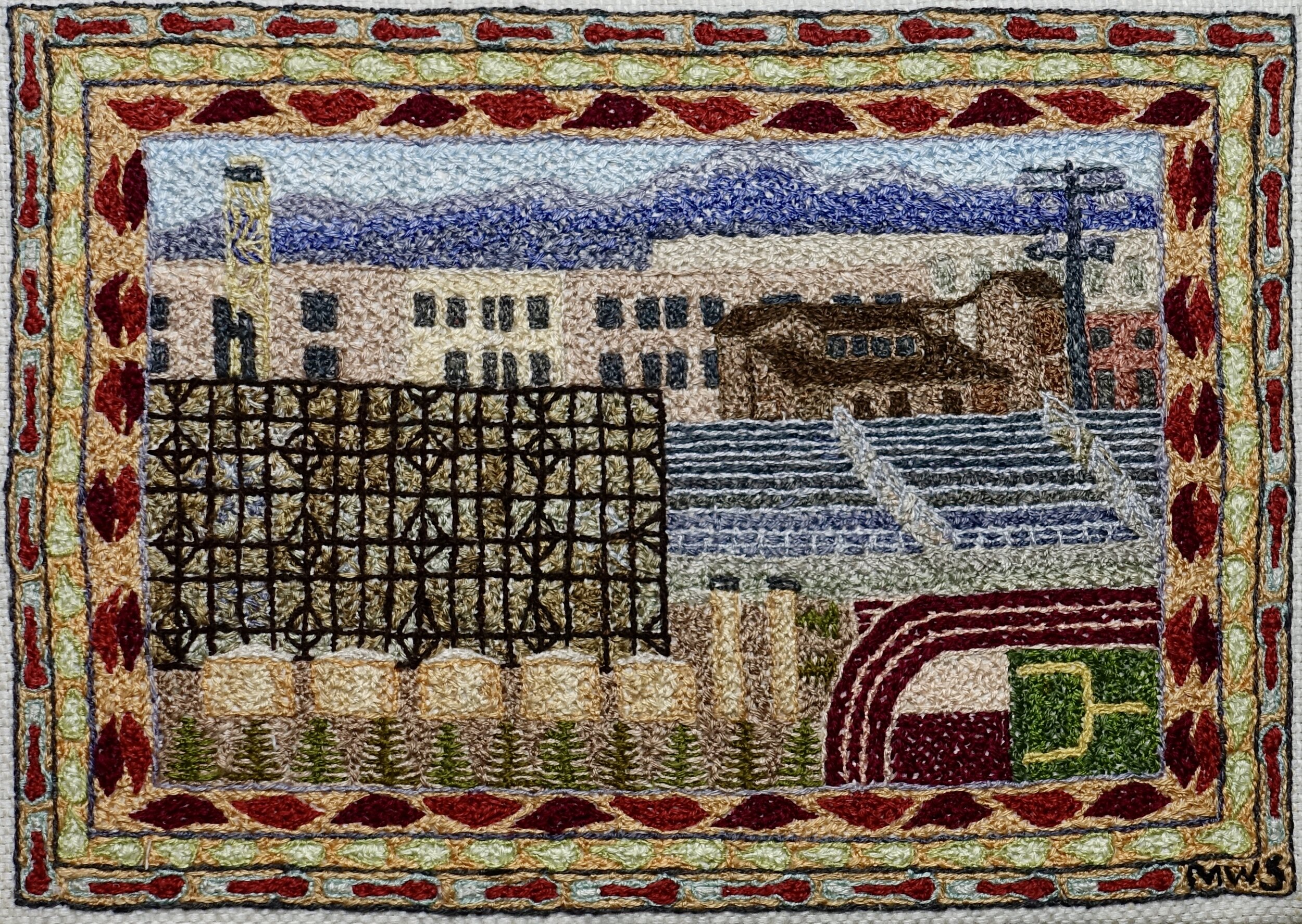
Martha Shade | Fracking Highschool | Hand-stitched cotton thread on linen Part of my 'Fracking Weld County' series, this piece is a symbolic depiction of a High School in Greeley, Co., where fracking wells sit a few hundred feet away. Inspired by Afghan war rugs and utilizing similar visual motifs of repeating images including thermometers, flames, and air particles.
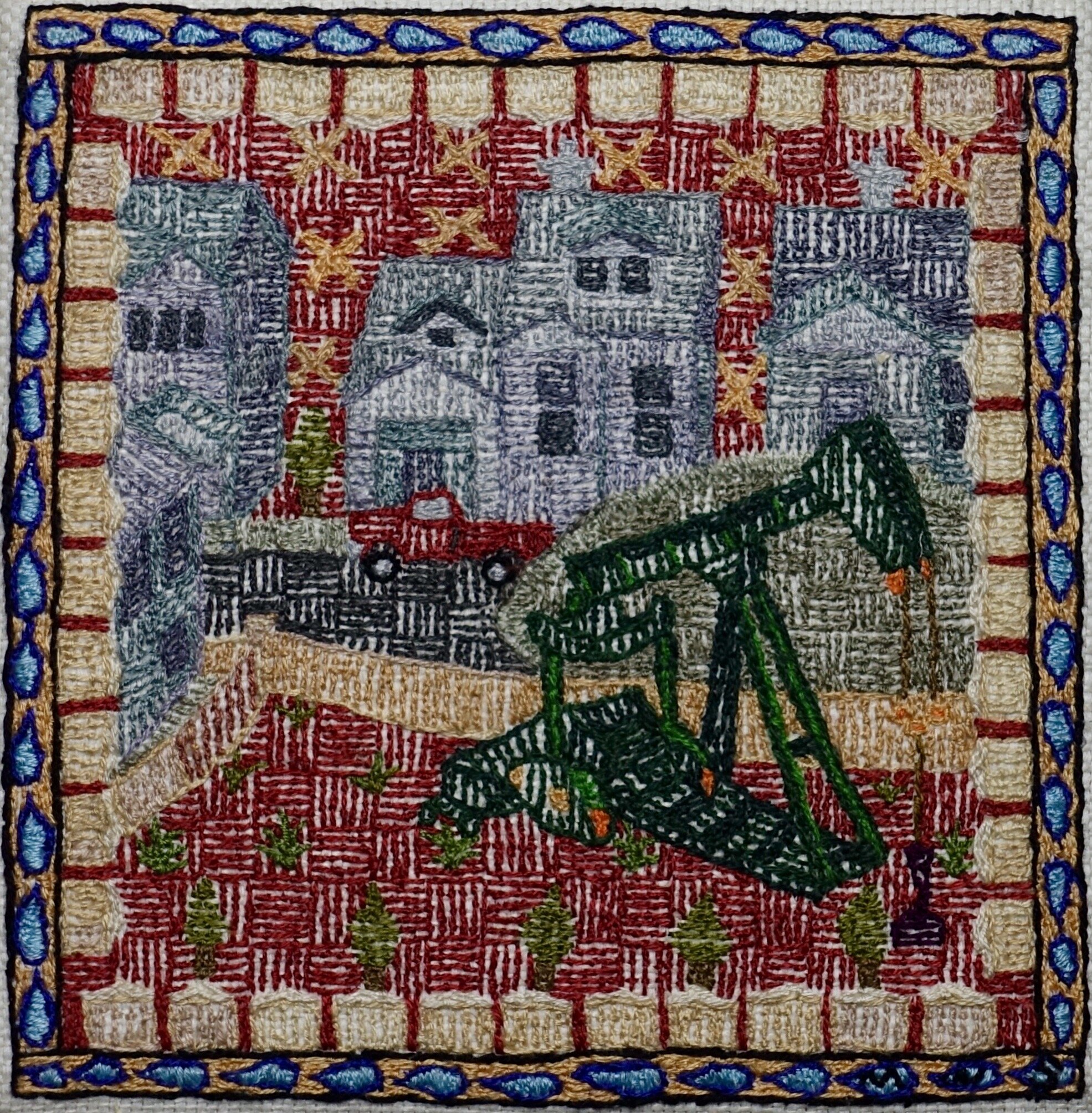
Martha Shade | Fracking Neighborhood | Hand-stitched cotton thread on linen Part of my 'Fracking Weld County' series, this small hand-stitched piece is a symbolic depiction of drilling paraphernalia within a neighborhood. I created it by referencing photographs of actual fracking sites in Weld County, Colorado. Inspired by woven textiles, especially Afghan war rugs.
